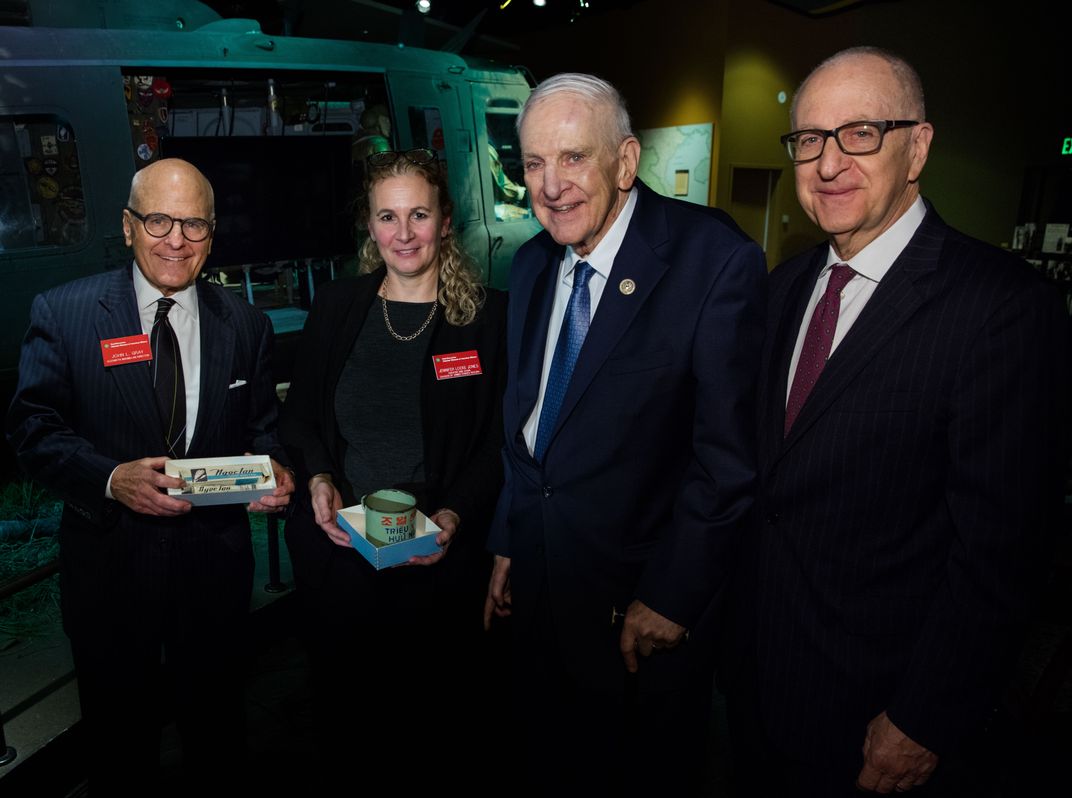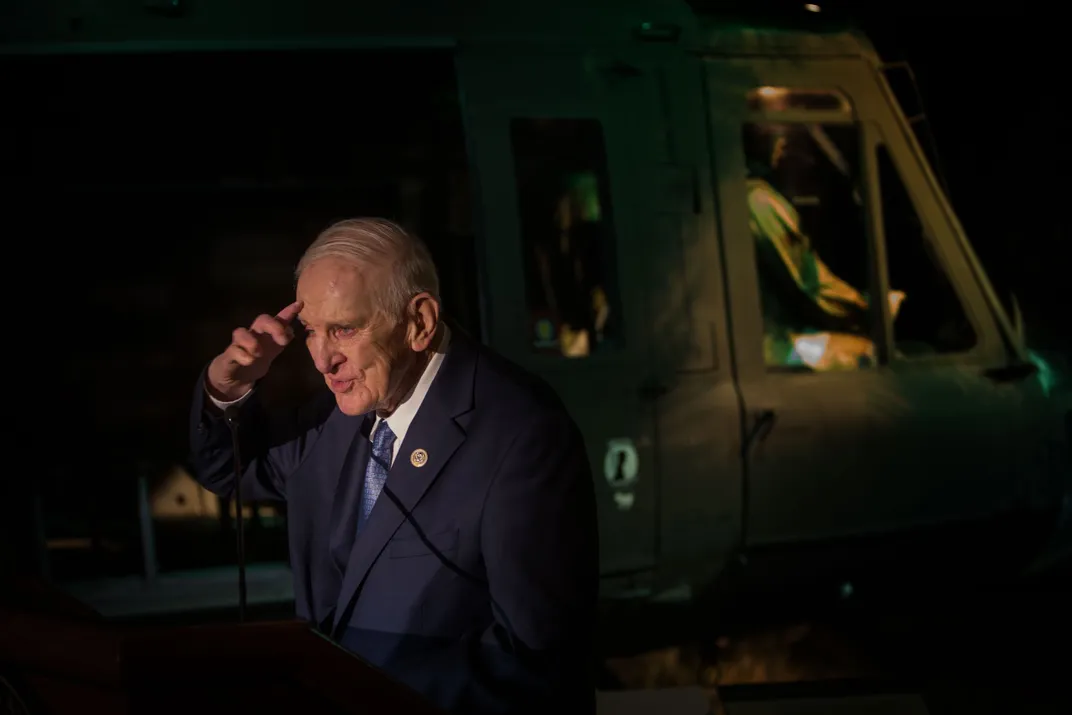The Indomitable Spirit of American POWs Lives On in These Vietnam Prison Keepsakes
For seven years an internee at the infamous “Hanoi Hilton,” Congressman Sam Johnson entrusts his story to the Smithsonian
:focal(3120x2370:3121x2371)/https://tf-cmsv2-smithsonianmag-media.s3.amazonaws.com/filer/10/88/1088067e-b9ab-46ca-a66a-facfb50c7b52/pow3.jpg)
If the cold metallic frame and sharp rotor blades of the Smithsonian’s 1966 Bell Huey helicopter evoke the impersonality and mechanization of the Vietnam War, the humble cup and tube of toothpaste donated to the National Museum of American History earlier this week bring into stark focus the conflict’s human cost.
The donor of these unassuming but poignant items is Texas representative Sam Johnson, a decorated Air Force Colonel who spent seven of his 29 years of service detained as a prisoner of war in the brutal northern Vietnamese detention complex called Hỏa Lò. The facility is now best remembered as the “Hanoi Hilton,” but Johnson says he and his fellow captives had a less facetious nickname for it: Hell on Earth.
For the duration of Col. Johnson’s time in Hỏa Lò, the cup and tube were the only worldly possessions he could claim. As he told a group of friends, family and journalists assembled in the museum’s exhibition “Price of Freedom: Americans at War,” where the Bell Huey chopper is prominently displayed, the cup in particular became a cherished symbol of hope in his sustained struggle against creeping despair.
“The tin cup served many purposes,” the 88-year-old congressman (slated to retire this year) told his audience, “but most importantly, it was a way for me and my fellow captives—in particular, Bob Shumaker—to communicate.” Shumaker, a rear admiral in the Navy who had been locked in a cell adjacent to Johnson’s, nodded knowingly from his place among the distinguished guests.

“We would hold our cups against the wall,” Johnson said, “and they served as amplifiers to hear the tap code.” The tap code was a system of Morse-like finger taps that allowed the prisoners to communicate whole sentences to each other, one painstakingly transmitted letter at a time. Thanks to the cups, Johnson said, “the North Vietnamese couldn’t hear us tapping.”
Johnson’s dingy cup, which he smuggled out of the prison against direct orders (along with the toothpaste tube) upon his release, is clearly an object he holds near and dear to his heart. “That tin cup was a lifeline for so many years,” he said, “and it reminds me of God’s faithfulness to provide friendships that give you the strength to survive through even the darkest times.”
The hardship of those dark times lives on for Johnson in the other object he donated. “The toothpaste,” he said, “if you can call it that, is a reminder of the bleak conditions we were in, and our determination to survive despite the North Vietnamese efforts to treat us as less than human.” Tubes like this were standard-issue for Hỏa Lò detainees; their contents were revolting in taste as well as texture.
Members both of the sequestered 11 Americans known as the “Alcatraz Gang,” Johnson and Shumaker were subjected to especially relentless abuse by their guards. When the Vietnamese finally told Johnson he was free to go, his first thought was that it was just one more sadistic mind game in a long series.

“They lied to us many times and for many years,” he said. “They lined me up for a mock firing squad, and they tried to convince us that we were forgotten and alone.” Incredibly, though, Operation Homecoming was reality: Johnson, Shumaker and the other Hỏa Lò inmates were liberated in early 1973. Johnson had been a captive for 2,494 days.
Johnson finally retired from the Air Force in 1979, but he did not by any means vanish from the public eye, or abandon his commitment to bettering his country. Rather, he started in on a decades-long congressional career as a Texan representative, and in 1995 joined the Smithsonian Board of Regents. Chief Justice John Roberts, the current chancellor of the Board, was present for Johnson’s donation ceremony.
“When my wife and I look at your memoir,” Smithsonian Secretary David Skorton said to the congressman, “we commonly say to each other that if there’s one person who embodies not only the definition but the spirit of service, it’s you.”
Armed forces history curator Jennifer Jones explains that the claustrophobic design of the museum's POW exhibit was entirely intentional. “When you walk into the space,” she says, “it has a very low ceiling, it’s very dark, and it’s very bleak-looking. We did that on purpose, because it gives you a sense of confined space. We created an atmosphere around those objects that I hope gives you a sense of some of the things the POWs were dealing with.”

While Col. Johnson’s cup and toothpaste tube are not the first Hỏa Lò artifacts to enter the Smithsonian’s collection, Jones says the fact Johnson himself made the donation and related his own story, combined with his status as a member of the Alcatraz Gang and an enduring paragon of public service, make these mementos especially powerful testaments to the reality of life as a POW.
Jones is hopeful Johnson’s contributions will enable museumgoers “to look at one person’s experience and one person’s objects and broaden that out to a larger discussion.” She sees the cup and tube as symbols of the tremendous sacrifice all U.S. military personnel—and their families—are prepared to make on behalf of their nation.
“What appears to be an insignificant item, like a cup,” says Jones, “really embodies a massive story of perseverance and personal sacrifice. Our soldiers, every one of them, are ready to do exactly what Col. Johnson did at any time. Their service is much larger than putting on a uniform.”
For Johnson, the title of the “Price of Freedom” exhibition couldn’t ring truer. Emotion welling in his voice as he concluded his remarks, the congressman recalled words a fellow prisoner had etched into one of Hỏa Lò’s walls: “Freedom has a taste to those who fight and almost die that the protected will never know.”
The “Price of Freedom: Americans at War” exhibition is permanently on view at the National Museum of American History in Washington, D.C.
/https://tf-cmsv2-smithsonianmag-media.s3.amazonaws.com/accounts/headshot/DSC_02399_copy.jpg)
/https://tf-cmsv2-smithsonianmag-media.s3.amazonaws.com/accounts/headshot/DSC_02399_copy.jpg)